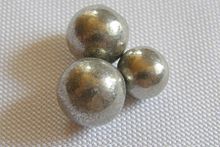Nickel tetracarbonyl

| |||
| |||
| Names | |||
|---|---|---|---|
| IUPAC name
Tetracarbonylnickel
| |||
| Other names
Nickel tetracarbonyl
Nickel carbonyl (1:4) | |||
| Identifiers | |||
3D model (
JSmol ) |
|||
| 6122797 | |||
| ChEBI | |||
| ChemSpider | |||
ECHA InfoCard
|
100.033.322 | ||
| EC Number |
| ||
| 3135 | |||
PubChem CID
|
|||
RTECS number
|
| ||
| UNII | |||
| UN number | 1259 | ||
CompTox Dashboard (EPA)
|
|||
| |||
| |||
| Properties | |||
| Ni(CO)4 | |||
| Molar mass | 170.73 g/mol | ||
| Appearance | colorless liquid[1] | ||
| Odor | musty,[1] like brick dust | ||
| Density | 1.319 g/cm3 | ||
| Melting point | −17.2 °C (1.0 °F; 256.0 K) | ||
| Boiling point | 43 °C (109 °F; 316 K) | ||
| 0.018 g/100 mL (10 °C) | |||
| Solubility | miscible in most | ||
| Vapor pressure | 315 mmHg (20 °C)[1] | ||
| Viscosity | 3.05 x 10−4 Pa s | ||
| Structure | |||
| Tetrahedral | |||
| Tetrahedral | |||
| zero | |||
| Thermochemistry | |||
Std molar
entropy (S⦵298) |
320 J K−1 mol−1 | ||
Std enthalpy of (ΔfH⦵298)formation |
−632 kJ/mol | ||
Std enthalpy of (ΔcH⦵298)combustion |
−1180 kJ/mol | ||
| Hazards | |||
| Occupational safety and health (OHS/OSH): | |||
Main hazards
|
Potential occupational carcinogen[2] | ||
| GHS labelling: | |||
   
| |||
| H225, H300, H301, H304, H310, H330, H351, H360D, H410 | |||
| P201, P202, P210, P233, P240, P241, P242, P243, P260, P271, P273, P280, P281, P284, P303+P361+P353, P304+P340, P308+P313, P310, P320, P370+P378, P391, P403+P233, P403+P235, P405, P501 | |||
| NFPA 704 (fire diamond) | |||
| Flash point | 4 °C (39 °F; 277 K) | ||
| 60 °C (140 °F; 333 K) | |||
Explosive limits
|
2–34% | ||
| Lethal dose or concentration (LD, LC): | |||
LC50 (median concentration)
|
266 ppm (cat, 30 min) 35 ppm (rabbit, 30 min) 94 ppm (mouse, 30 min) 10 ppm (mouse, 10 min)[3] | ||
LCLo (lowest published)
|
360 ppm (dog, 90 min) 30 ppm (human, 30 min) 42 ppm (rabbit, 30 min) 7 ppm (mouse, 30 min)[3] | ||
| NIOSH (US health exposure limits): | |||
PEL (Permissible)
|
TWA 0.001 ppm (0.007 mg/m3)[1] | ||
REL (Recommended)
|
TWA 0.001 ppm (0.007 mg/m3)[1] | ||
IDLH (Immediate danger) |
Ca [2 ppm][1] | ||
| Safety data sheet (SDS) | ICSC 0064 | ||
| Related compounds | |||
Related metal carbonyls
|
| ||
Except where otherwise noted, data are given for materials in their standard state (at 25 °C [77 °F], 100 kPa).
| |||
Nickel carbonyl (
Structure and bonding
In nickel tetracarbonyl, the
Preparation
Ni(CO)4 was first synthesised in 1890 by Ludwig Mond by the direct reaction of nickel metal with carbon monoxide.[6] This pioneering work foreshadowed the existence of many other metal carbonyl compounds, including those of vanadium, chromium, manganese, iron, and cobalt. It was also applied industrially to the purification of nickel by the end of the 19th century.[7]
At 323 K (50 °C; 122 °F), carbon monoxide is passed over impure nickel. The optimal rate occurs at 130 °C.[8]
Laboratory routes
Ni(CO)4 is not readily available commercially. It is conveniently generated in the laboratory by carbonylation of commercially available bis(cyclooctadiene)nickel(0).[9] It can also be prepared by reduction of ammoniacal solutions of nickel sulfate with sodium dithionite under an atmosphere of CO.[10]
Reactions

Thermal decarbonylation
On moderate heating, Ni(CO)4 decomposes to carbon monoxide and nickel metal. Combined with the easy formation from CO and even very impure nickel, this decomposition is the basis for the Mond process for the purification of nickel or plating onto surfaces. Thermal decomposition commences near 180 °C (356 °F) and increases at higher temperature.[8]
Reactions with nucleophiles and reducing agents
Like other low-valent metal carbonyls, Ni(CO)4 is susceptible to attack by nucleophiles. Attack can occur at nickel center, resulting in displacement of CO ligands, or at CO. Thus, donor ligands such as
Treatment with hydroxides gives clusters such as [Ni5(CO)12]2− and [Ni6(CO)12]2−. These compounds can also be obtained by reduction of nickel carbonyl.
Thus, treatment of Ni(CO)4 with carbon nucleophiles (Nu−) results in acyl derivatives such as [Ni(CO)3C(O)Nu)]−.[12]
Reactions with electrophiles and oxidizing agents
Nickel carbonyl can be oxidized. Chlorine oxidizes nickel carbonyl into NiCl2, releasing CO gas. Other halogens behave analogously. This reaction provides a convenient method for precipitating the nickel portion of the toxic compound.
Reactions of Ni(CO)4 with alkyl and aryl halides often result in carbonylated organic products.
Toxicology and safety considerations
The hazards of Ni(CO)4 are far greater than that implied by its CO content, reflecting the effects of the nickel if released in the body. Nickel carbonyl may be fatal if absorbed through the skin or more likely, inhaled due to its high volatility. Its
The vapours of Ni(CO)4 can autoignite. The vapor decomposes quickly in air, with a half-life of about 40 seconds.[15]
Nickel carbonyl poisoning is characterized by a two-stage illness. The first consists of
It is classified as an
In popular culture
"Requiem for the Living" (1978), an episode of Quincy, M.E., features a poisoned, dying crime lord who asks Dr. Quincy to autopsy his still-living body. Quincy identifies the poison—nickel carbonyl.
In the 1979 novella Amanda Morgan by Gordon R. Dickson, the remaining inhabitants of a mostly evacuated village resist an occupying military force by directing the exhaust from a poorly-tuned internal combustion engine onto a continually renewed "waste heap" of powdered nickel outside a machine shop (under the guise of civilian business) in order to eliminate the occupiers, at the cost of their own lives.
In chapter 199 of the
In the 2019 novel Delta-v from New York Times bestselling author Daniel Suarez a team of eight private miners reach a near-earth asteroid to extract volatiles (water, CO2, etc.) and metals (iron, nickel and cobalt); these are stored as solid carbonyl for transfer back to near Earth orbit, and used for in-situ fabrication of a spacecraft, via decomposition in vacuum.
References
- ^ a b c d e f NIOSH Pocket Guide to Chemical Hazards. "#0444". National Institute for Occupational Safety and Health (NIOSH).
- ^ Nickel tetracarbonyl, carcinogenicity
- ^ a b "Nickel carbonyl". Immediately Dangerous to Life or Health Concentrations (IDLH). National Institute for Occupational Safety and Health (NIOSH).
- The Merck Index (7th ed.). Merck.
- doi:10.1063/1.437911.
- .
- doi:10.1038/059063a0.
- ^ ISBN 978-3527306732.
- ISBN 0-08-025269-9.
- ^ F. Seel (1963). "Nickel Carbonyl". In G. Brauer (ed.). Handbook of Preparative Inorganic Chemistry. Vol. 2 (2nd ed.). NY: Academic Press. pp. 1747–1748.
- ISBN 3-527-28165-7.
- ISBN 0471936235.
- ^ Semmelhack, M. F.; Helquist, P. M. (1972). "Reaction of Aryl Halides with π-Allylnickel Halides: Methallylbenzene". Organic Syntheses. 52: 115; Collected Volumes, vol. 6, p. 722.
- PMID 25032325.
- S2CID 31344783.
- ^ "40 C.F.R.: Appendix A to Part 355—The List of Extremely Hazardous Substances and Their Threshold Planning Quantities" (PDF) (July 1, 2008 ed.). Government Printing Office. Archived from the original (PDF) on February 25, 2012. Retrieved October 29, 2011.
{{cite journal}}: Cite journal requires|journal=(help)
Further reading
- Shi, Z. (1991). "Nickel Carbonyl: Toxicity and Human Health". Science of the Total Environment. 148 (2–3): 293–298. PMID 8029705.
- Sunderman, F. W. (1989). "A Pilgrimage into the Archives of Nickel Toxicology". Annals of Clinical and Laboratory Science. 19 (1): 1–16. PMID 2644888.
- Armit, H. W. (1907). "The Toxicology of Nickel Carbonyl. Part I". Journal of Hygiene. 7 (4): 525–551. PMID 20474327.
- Armit, H. W. (1908). "The Toxicology of Nickel Carbonyl. Part II". Journal of Hygiene. 8 (5): 565–610. PMID 20474374.
- Barceloux, D. G.; Barceloux, Donald (1999). "Nickel". Clinical Toxicology. 37 (2): 239–258. PMID 10382559.




